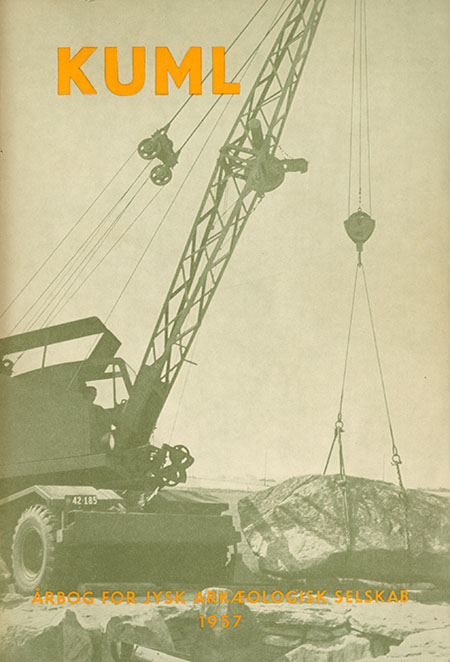Storstensgrave ved Tustrup
DOI:
https://doi.org/10.7146/kuml.v7i7.97363Keywords:
Megalithic Tomb, megalitgrav, Tustrup, Stone age cemetary, stenalder gravplads, temple, tempelAbstract
Megalithic Tombs at Tustrup
The investigation of the Stone Age cemetery at Tustrup, and the reconstruction of the monuments there, has now been completed. Since the first report in KUML 1955, where the main emphasis was given to the results of the excavation of the temple and to the objects discovered in the free standing dolmen chamber, the passage grave, the round dolmen and the whole area covered by the cemetery have now been investigated.
The chamber of the passage grave only produced one artifact, a pierced connecting head of amber. On the other hand, the area in front of and to both sides of the entrance, which was bordered towards the tumulus by 7, originally 8, facade stones (fig. 4), produced a rich store of pottery. Pedestalled bowls, ladles, carinated vessels, funnel-necked beakers and other well-formed and finely decorated ware either stood behind the facade stones or lay where they had fallen in front af them. The position of the vessels and the facade stones which delimit the area suggest that it was a cult area and the vessels offerings. Analogous layouts are found in association with about 30 other Danish passage graves, while delimited offering areas are also found in Western Europe (fig. 5) and Sweden. Behind the north wall of the main chamber of the passage grave, the 10-meter length of which makes it the largest in East Jutland, a quite large secondary chamber was found (figs. 2 & 3), measuring 2,4 meters in length and 1,6 meters in breadth. The entrance to this chamber lay between the two westernmost supporting orthostats, one of which had a naturally curved side, while the other had been cut to shape, to form an entrance shaped like a symmetrical pointed arch (fig. 3). This door construction may be compared with the "soul-hole" doors found in megalith graves of West and Central Europe and in a single Swedish specimen.
The chamber in the round dolmen was also empty. But outside the ring-stones, mainly in front of and to either side of the entrance to the chamber, quite considerable quantities of potsherds were found, of Middle Neolithic ware, including pedestalled bowls and carinated vessels. These vessels were found underneath stones which had fallen from the body of the tumulus and under layers of flat slabs which showed that the intervals between the ringstones, which were about 2 meters high, had been filled with dry walling to a considerable height (fig. 8). The vessel appeared to have originally stood upon these dry-stone walls. between the ring-stones. In addition, half of a battle-axe of Fredgaarde type was found in the heap of stones in front of the entrance to the chamber, perhaps a throw-out from the chamber.
The pottery from all three graves is very uniform, and very closely connected in type to that found inside the cult building. The objects discovered thus appear to confirm the conclusion suggested by the layout of the site, that all the graves were built at the same time and in accordance with an over-all plan.
The whole of the terrace occupied by the cemetery was investigated by means of trial trenches, 1,5 meters wide and set at intervals of 2 meters. Apart from a single empty grave, of a type suggesting a Neolithic date, only 4 cremation graves were found, of which one (fig. 9) could be dated by its pottery contents to the Early lron Age, while the others were empty (fig. 10).
The contemporaneity of these three megalith graves of widely different types on the same site raises the whole question of the character of the Danish megalith graves and of the significance of the typological differences.
P. Kjærum
Downloads
Published
How to Cite
Issue
Section
License
Fra og med årgang 2022 er artikler udgivet i Kuml med en licens fra Creative Commons (CC BY-NC-SA 4.0).
Alle tidligere årgange af tidsskriftet er ikke udgivet med en licens fra Creative Commons.


